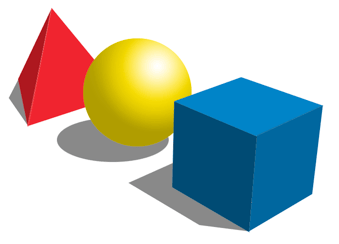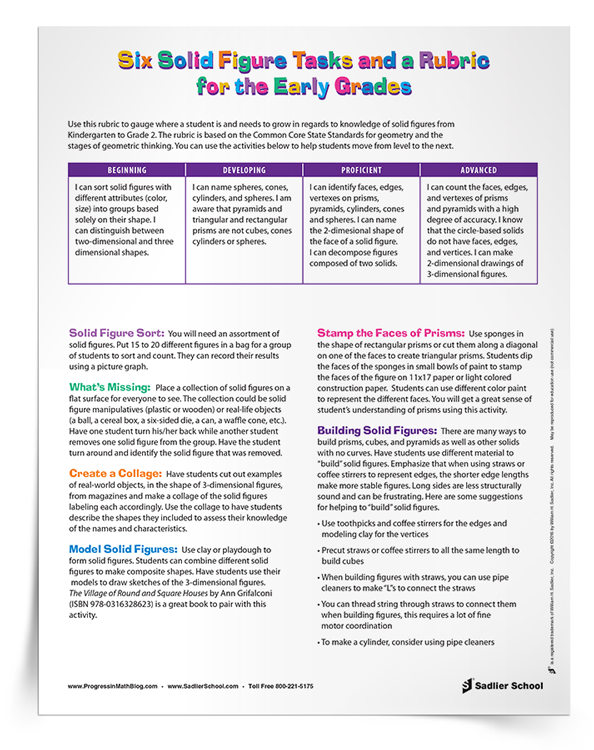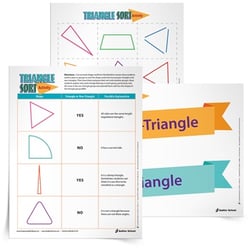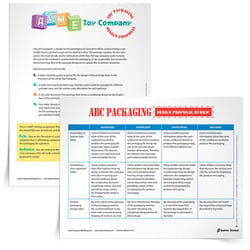June 23, 2016 k-2-geometry
Solid Figure Activities with 3 Dimensional Figures for the Early Grades
By: Jeff Todd
Teaching the concept of solid figures starts very early on in a child’s education, often pre-school but for most in Kindergarten. There are several solid figure worksheets you can find online, but I want to share some engaging solid figure activities that will keep kids interested and talking about what they are learning about 3 dimensional figures. The download for this post is six great solid figure activities and includes a rubric to help students and teachers assess progress in students’ understanding of solid figures. The activities can be used extend lessons in the Progress in Mathematics series for Kindergarten to Grade 2.
 First, here’s a little bit about the stages of development for student geometrical thinking and how they relate to 3 dimensional figures.
First, here’s a little bit about the stages of development for student geometrical thinking and how they relate to 3 dimensional figures.
Stage 1: Students cannot distinguish between different 3 dimensional figures.
Stage 2: Students are able to identify instances of these shapes—it’s a sphere—but cannot tell why. At this stage, students might have trouble differentiating between cubes and other rectangular prisms.
Stage 3: Students are able to describe the characteristics of 3 dimensional figures such as faces, edges, vertexes, and straight lines or curves. The student at this stage can tell the difference between a cube and a non-cubic rectangular prism
Most students, Kindergarten through Second Grade move through these stages of development. The solid figure activities that you can download in this post are designed to help students move through the various stages. These activities can be used to help lead all students to Stage 3 of understanding 3 dimensional figures.
The solid figures activities will require various materials in the shape of cubes, cylinders, cones, spheres, pyramids, rectangular prisms, and triangular prisms. Wooden or larger (3 to 4”) plastic shape sets are great for you to use for demonstration purposes. Tubs of smaller plastic shapes for students to sort would be helpful, and there are shape set tubs available online if your school doesn’t provide them. Straws, coffee stirrers, toothpicks, clay, playdough, pipe cleaners, and string are also great resources for students to “construct” 3-dimensional figures.
Here is a brief list of the geometric concepts, in regards to 3-dimensional figures, students should know at each grade level:
-
Kindergarten: Students should know the difference between flat (2-dimensional) and solid (3-dimensional) figures, the names of common 3 dimensional figures (cube, sphere, cone, cylinder), and the names of the faces on common solid figures such as prisms and pyramids.
-
First Grade: Students should know the difference between a cube and a rectangular prism as well as how to compose (put together shapes to “build” other shapes) and decompose (take apart shapes to form separate shapes) solid figures.
-
Second Grade: Students should begin to draw three-dimensional figures, specifically cubes, and recognize the attributes of a cube (all edges equal length, all faces made of squares, all right angles).
In order for students to develop a deep understanding of geometric concepts, it’s going to take more than solid figure worksheets. Students need many opportunities for hands-on activities with 3 dimensional figures. I am not saying there’s not a time and place for worksheets, but this might not be one of them. To find some solid figure activities that will help your students learn about these shape and a rubric that you can use to tell their progress, click on the button below.
These activities would be great to enhance the teaching of solid figures in Progress in Mathematics, Kindergarten Chapter 2 Lessons 1 to 4, Grade 1 Chapter 7 Lessons 5 to 9, and Grade 2 Chapter 6 Lessons 1 and 2.








